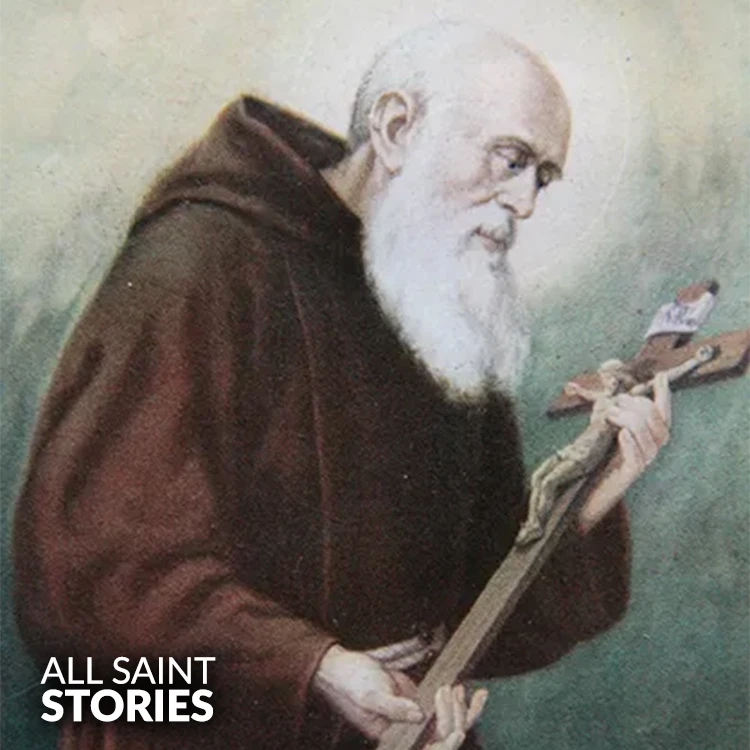St. Conrad of Parzham, gentle servant of Christ, teach us to find holiness in the ordinary. Help us serve with patience, listen with love, and remain faithful in every duty. May your quiet strength and deep prayer inspire us to trust more deeply in God’s plan. Intercede for us, that we may grow in humility and compassion. Amen.
ST. CONRAD OF PARZHAM
ST. CONRAD OF PARZHAM

St. Conrad of Parzham was a humble Capuchin lay brother known for his unwavering devotion, charity, and service as a porter for over 40 years.
St. Conrad of Parzham, born Johann Birndorfer, came into the world on December 22, 1818, in the small village of Parzham in Bavaria, Germany. He was the eleventh of twelve children born to a devout and hardworking farming family. From a young age, Johann displayed deep piety, humility, and a preference for prayer and solitude over the common amusements of his peers. Despite the physical demands of farm life, he maintained a spirit of peace and devotion, often rising early to attend Mass and spend time in contemplation.
After the death of his parents, Johann increasingly felt drawn to religious life. At age 31, he joined the Capuchin Franciscans, a branch of the Franciscan order known for their simplicity and dedication to the poor. Taking the name Conrad, he began his novitiate in 1849 and professed his final vows in 1852. He was assigned to the Shrine of Our Lady in Altötting, one of the most important pilgrimage sites in Germany. There, he served as porter—a humble doorkeeper—for over 40 years.
Though his role may have seemed simple, St. Conrad's position put him in constant contact with hundreds of people daily: the poor, the sick, pilgrims, and those in need of counsel or prayer. He welcomed everyone with kindness, listening with patience, offering small comforts, and always ready with a prayer or word of encouragement. He would often give away his own food or clothing to help others.
What made St. Conrad extraordinary was the depth of his inner life. He spent all the time he could in adoration before the Blessed Sacrament and maintained a spirit of continual prayer. His silence, humility, and faith were so profound that many came to believe he had the gift of reading souls. He endured physical ailments, especially toward the end of his life, with patience and trust in God.
St. Conrad died on April 21, 1894, the very day of his feast. His death was marked by an outpouring of devotion from the people he had served so quietly for decades. He was canonized in 1934, and his life remains a testimony to the holiness found in everyday service and hidden sacrifice.
Video Not Found
The information on this website is compiled from various trusted sources. While we aim for accuracy, some details may be incomplete or contain discrepancies.
If you notice any errors or have additional information about this saint, please use the form on the left to share your suggestions. Your input helps us improve and maintain reliable content for everyone.
All submissions are reviewed carefully, and your personal details will remain confidential. Thank you for contributing to the accuracy and value of this resource.
Credits & Acknowledgments
- Anudina Visudhar (Malayalam) – Life of Saints for Everyday
by Msgr. Thomas Moothedan, M.A., D.D. - Saint Companions for Each Day
by A. J. M. Mausolfe & J. K. Mausolfe - US Catholic (Faith in Real Life) – Informational articles
- Wikipedia – General reference content and images
- Anastpaul.com – Saint images and reflections
- Pravachaka Sabdam (Malayalam) – Saint-related content and insights
We sincerely thank these authors and platforms for their valuable contributions. If we have unintentionally missed any attribution, please notify us, and we will make the correction promptly.
If you have any suggestion about ST. CONRAD OF PARZHAM
Your suggestion will help improve the information about this saint. Your details will not be disclosed anywhere.
© 2025 Copyright @ www.allsaintstories.com




 English
English
 Italian
Italian
 French
French
 Spanish
Spanish
 Malayalam
Malayalam
 Russian
Russian
 Korean
Korean
 Sinhala
Sinhala
 Japanese
Japanese
 Arabic
Arabic
 Portuguese
Portuguese
 Bantu
Bantu
 Greek
Greek
 German
German
 Dutch
Dutch
 Filipino
Filipino